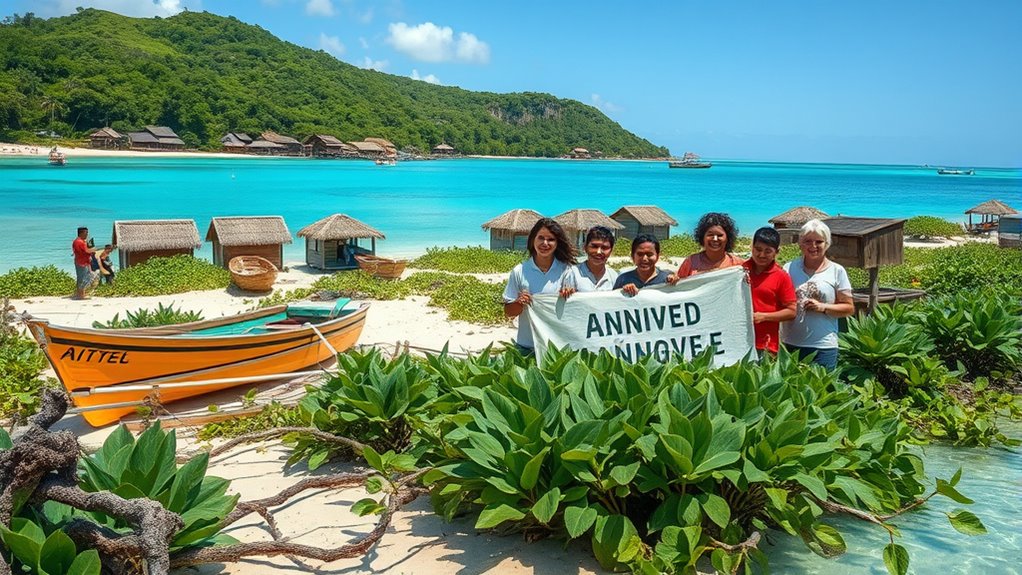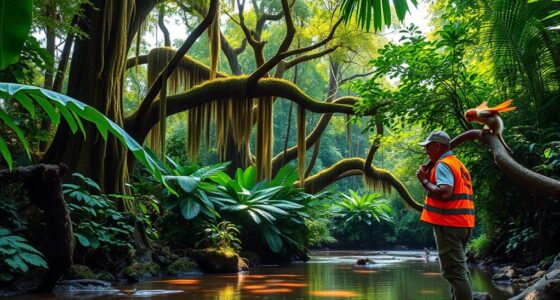Around the world, community-led conservation efforts show how indigenous knowledge and eco tourism foster sustainability. You’ll find examples like Central American tribes protecting forests with traditional land management and African communities developing eco lodges that support wildlife and culture. These initiatives generate income, empower locals, and promote environmental health. If you keep exploring, you’ll uncover inspiring stories of how Indigenous practices and eco tourism work together to create lasting positive impacts for nature and communities alike.
Key Takeaways
- Indigenous communities in Central America have established protected areas using traditional land management to prevent deforestation.
- African communities near national parks develop eco lodges that promote conservation and cultural education.
- Local guides trained in sustainable tourism lead eco tours, showcasing ancestral knowledge and fostering environmental respect.
- Community-led conservation projects integrating indigenous practices have resulted in successful environmental preservation.
- Eco tourism creates economic benefits for communities, incentivizing habitat protection and long-term sustainability.

Have you ever wondered how local communities can turn the tide on environmental decline? It’s often through their deep-rooted understanding of indigenous practices and the innovative eco tourism initiatives they develop. These strategies not only protect their natural surroundings but also empower residents economically and culturally. Indigenous practices, passed down through generations, emphasize harmonious coexistence with nature. These traditions often include sustainable farming, fishing, and forest management techniques that minimize environmental impact. When communities embrace these practices, they become stewards of their land, ensuring that resources are preserved for future generations.
Eco tourism initiatives serve as a bridge, transforming traditional knowledge into sustainable economic opportunities. Instead of exploiting natural resources for short-term gains, communities develop eco-friendly tourism experiences that highlight their unique cultural and environmental assets. For example, guiding visitors through pristine rainforests or coral reefs while sharing indigenous stories fosters respect and awareness for the environment. These initiatives also generate income, creating incentives to conserve rather than destroy natural habitats. Visitors leave with a deeper appreciation for the area’s biodiversity and cultural heritage, which, in turn, boosts local pride and motivation to continue conservation efforts.
Around the world, communities have successfully combined indigenous practices with eco tourism initiatives to achieve remarkable results. In parts of Central America, indigenous groups have established protected areas where traditional land management techniques prevent deforestation and soil erosion. Local guides, trained in sustainable tourism, lead eco tours that showcase their ancestral knowledge, attracting eco-conscious travelers. Similarly, in Africa, communities near national parks have developed eco lodges that operate sustainably, emphasizing conservation and cultural education. These lodges provide a sustainable revenue stream, encouraging the community to safeguard wildlife and their environment.
What makes these stories inspiring is how they demonstrate that conservation isn’t just about protecting nature; it’s about empowering communities to take ownership of their environment. When local residents see tangible benefits from conservation, they’re more likely to invest in its long-term success. Indigenous practices provide a foundation rooted in respect for nature, while eco tourism initiatives create a viable economic model that aligns with conservation goals. Together, these approaches foster a positive cycle of preservation and prosperity, proving that community-led efforts can truly turn environmental decline around. In addition, fostering awareness of local cultural heritage further enhances community engagement and preservation efforts. Recognizing the importance of sustainable land management helps communities develop effective conservation strategies that are culturally appropriate and environmentally sound. Understanding conservation success stories from diverse regions also inspires new initiatives and innovative solutions worldwide. Developing community-led conservation projects encourages local ownership and long-term sustainability, making these efforts more resilient.
Furthermore, embracing indigenous knowledge enhances the effectiveness of conservation projects by integrating traditional practices with modern environmental science. So, if you ever visit such places, remember that behind the scenes are communities actively shaping a sustainable future through their wisdom and innovation.
Frequently Asked Questions
How Do Community Conservation Efforts Impact Local Economies?
Community conservation efforts positively impact your local economy by promoting eco-tourism benefits, which attract visitors and generate income. You can see increased employment opportunities and support for small businesses. These initiatives foster sustainable livelihoods, ensuring resources are preserved for future generations while boosting economic stability. By participating, you help create a resilient community that values environmental health and economic growth, making your area more attractive and prosperous.
What Challenges Do Communities Face in Maintaining Conservation Programs?
You face challenges in maintaining conservation programs, especially around stakeholder engagement and resource allocation. Engaging local communities, governments, and organizations requires ongoing effort and clear communication. Limited resources can hinder proper implementation and enforcement. Balancing economic needs with conservation goals often complicates decisions. Despite these hurdles, prioritizing stakeholder involvement and efficiently allocating resources help sustain long-term success in conservation efforts.
How Are Traditional Knowledge and Practices Integrated Into Conservation?
Think of traditional knowledge as a guiding star illuminating conservation efforts. You can weave indigenous practices and cultural heritage into your strategies, respecting age-old wisdom that has preserved ecosystems for generations. By doing so, you honor the deep connection between communities and their land, making conservation efforts more authentic and sustainable. This integration creates a vibrant tapestry where modern solutions and traditional insights work hand in hand, fostering lasting environmental stewardship.
What Role Does Government Policy Play in Community-Led Conservation?
Government policy plays a vital role in community-led conservation by shaping governance frameworks and providing policy influence that empowers local communities. When policies support participatory decision-making and resource rights, you can actively engage in sustainable practices. Effective policies facilitate collaboration, offer legal protections, and allocate resources, helping communities succeed in conservation efforts. Your participation increases when governance frameworks are inclusive, transparent, and aligned with community needs and traditional practices.
How Can Communities Be Motivated to Participate in Conservation Initiatives?
Imagine vibrant forests and lively waters thriving because you’re part of something bigger. To motivate your community, harness the power of community engagement, making everyone feel their voice matters. Incentive programs, like rewards for conservation efforts, add excitement and tangible benefits. Show how conservation protects your land and future, inspiring pride. When you see the direct positive impact, you’ll be enthusiastic to join and sustain these essential initiatives.
Conclusion
As you reflect on these stories, imagine communities as vibrant tapestries woven with hope and resilience. Their dedication transforms landscapes from barren to breathtaking, proving that collective effort can turn the tide on environmental decline. When you see conservation efforts flourish through local hands, it’s like witnessing a sunrise after a long night—renewing, inspiring, and full of promise. Together, you can be part of this beautiful, ongoing story of nature’s revival.






